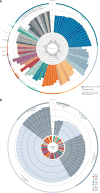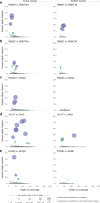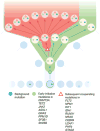Age-related mutations associated with clonal hematopoietic expansion and malignancies
- PMID: 25326804
- PMCID: PMC4313872
- DOI: 10.1038/nm.3733
Age-related mutations associated with clonal hematopoietic expansion and malignancies
Abstract
Several genetic alterations characteristic of leukemia and lymphoma have been detected in the blood of individuals without apparent hematological malignancies. The Cancer Genome Atlas (TCGA) provides a unique resource for comprehensive discovery of mutations and genes in blood that may contribute to the clonal expansion of hematopoietic stem/progenitor cells. Here, we analyzed blood-derived sequence data from 2,728 individuals from TCGA and discovered 77 blood-specific mutations in cancer-associated genes, the majority being associated with advanced age. Remarkably, 83% of these mutations were from 19 leukemia and/or lymphoma-associated genes, and nine were recurrently mutated (DNMT3A, TET2, JAK2, ASXL1, TP53, GNAS, PPM1D, BCORL1 and SF3B1). We identified 14 additional mutations in a very small fraction of blood cells, possibly representing the earliest stages of clonal expansion in hematopoietic stem cells. Comparison of these findings to mutations in hematological malignancies identified several recurrently mutated genes that may be disease initiators. Our analyses show that the blood cells of more than 2% of individuals (5-6% of people older than 70 years) contain mutations that may represent premalignant events that cause clonal hematopoietic expansion.
Figures





Similar articles
-
Epigenetic dysregulation of hematopoietic stem cells and preleukemic state.Int J Hematol. 2017 Jul;106(1):34-44. doi: 10.1007/s12185-017-2257-6. Epub 2017 May 29. Int J Hematol. 2017. PMID: 28555413 Review.
-
Emerging insights into epigenetics and hematopoietic stem cell trafficking in age-related hematological malignancies.Stem Cell Res Ther. 2024 Nov 6;15(1):401. doi: 10.1186/s13287-024-04008-4. Stem Cell Res Ther. 2024. PMID: 39506818 Free PMC article. Review.
-
Clonal hematopoiesis: Pre-cancer PLUS.Adv Cancer Res. 2019;141:85-128. doi: 10.1016/bs.acr.2018.12.003. Epub 2019 Jan 14. Adv Cancer Res. 2019. PMID: 30691686 Review.
-
Ultra-sensitive Sequencing Identifies High Prevalence of Clonal Hematopoiesis-Associated Mutations throughout Adult Life.Am J Hum Genet. 2017 Jul 6;101(1):50-64. doi: 10.1016/j.ajhg.2017.05.013. Epub 2017 Jun 29. Am J Hum Genet. 2017. PMID: 28669404 Free PMC article.
-
Clonal hematopoiesis as determined by the HUMARA assay is a marker for acquired mutations in epigenetic regulators in older women.Exp Hematol. 2016 Sep;44(9):857-865.e5. doi: 10.1016/j.exphem.2016.05.009. Epub 2016 May 26. Exp Hematol. 2016. PMID: 27235757 Free PMC article.
Cited by
-
Multistep tumorigenesis in peripheral T cell lymphoma.Int J Hematol. 2015 Nov;102(5):523-7. doi: 10.1007/s12185-015-1738-8. Epub 2015 Jan 28. Int J Hematol. 2015. PMID: 25628103 Review.
-
Chronic TNF in the aging microenvironment exacerbates Tet2 loss-of-function myeloid expansion.Blood Adv. 2024 Aug 13;8(15):4169-4180. doi: 10.1182/bloodadvances.2023011833. Blood Adv. 2024. PMID: 38924753 Free PMC article.
-
TET2: A cornerstone in normal and malignant hematopoiesis.Cancer Sci. 2021 Jan;112(1):31-40. doi: 10.1111/cas.14688. Epub 2020 Nov 18. Cancer Sci. 2021. PMID: 33048426 Free PMC article. Review.
-
Liquid biopsy in lymphoma: Molecular methods and clinical applications.Cancer Treat Rev. 2020 Dec;91:102106. doi: 10.1016/j.ctrv.2020.102106. Epub 2020 Sep 22. Cancer Treat Rev. 2020. PMID: 33049623 Free PMC article. Review.
-
High-sensitivity analysis of clonal hematopoiesis reveals increased clonal complexity of potential-driver mutations in severe COVID-19 patients.PLoS One. 2024 Jan 10;19(1):e0282546. doi: 10.1371/journal.pone.0282546. eCollection 2024. PLoS One. 2024. PMID: 38198467 Free PMC article.
References
-
- Limpens J, et al. Lymphoma-associated translocation t(14;18) in blood B cells of normal individuals. Blood. 1995;85:2528–2536. - PubMed
-
- Biernaux C, Loos M, Sels A, Huez G, Stryckmans P. Detection of major bcr-abl gene expression at a very low level in blood cells of some healthy individuals. Blood. 1995;86:3118–3122. - PubMed
Publication types
MeSH terms
Grants and funding
LinkOut - more resources
Full Text Sources
Other Literature Sources
Medical
Research Materials
Miscellaneous

